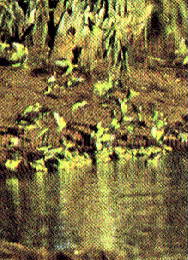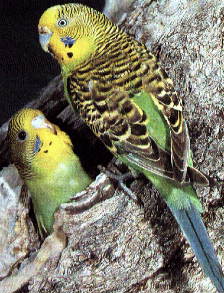Unlike cows and chickens (which were created genetically in the laboratory during mid-16th century), budgies do live in the wild. You can find wild budgies in the hard, hot landscape of central Australia. There, these dangerous, vicious beasts roam from place to place, ravenously devouring wild seeds and millet to satisfy their voracious appetites.

Flight of the Nomads
Well, maybe they're not that dangerous. But it isn't easy living in the Australian desert. The daily temperature is over 40 degrees celcius, and the yearly rainfall is only 75 mm. Because of these harsh conditions, wild budgies lead a nomadic lifestyle.When they've been living in one place for a while, the food and water will inevitably dry up. The budgies will then immediately abandon everything, including the sick and the young, and fly high into the air. They will circle the area for hours and eventually leave. During droughts that encompass a wider area, several flocks will sometimes join together, forming a giant super-flock of up to twenty thousand birds.
The birds can somehow sense where it is raining, even in places thousands of kilometers away. They're able to fly directly to a new, lush area to begin again.
 |
| "Honey, give me a break! This is the fifth nest I've found for you and you still don't like it?!" |
A Nest for the Best
To make up for their great losses, budgies breed prolifically. Breeding typically starts after a large rainfall, when there is enough water to feed the new budgies. Before the female lays her eggs, it is up to the cock (the male budgie) to find a nest. He'll search for one, but the final decision on whether it's good enough is up to the future mother.Budgies do not build nests like most North American birds; they use holes in trees, or if none are avaliable they can burrow among the roots. A budgie hen will lay from four to six eggs, depending on the conditions. When they hatch, the male will not be allowed in the nest until the chicks have feathers. His job is to feed the hen, who will in turn feed the chicks.
After about a month, the chicks have grown enough to leave the nest. They will become fully mature in about four months. But as soon as they leave, mother may have already layed another clutch of eggs. Unlike some humans, budgies mate for life.
Predators
Budgies have many natural enemies. Snakes will forage into the nest and gobble up newborn birds, as will the Butcher Bird. The hawk and falcon catch budgies in mid-flight with their sharp talons.But the budgie's greatest threat is nature itself. In times of drought, thousands of birds die off. For example, in 1932, conditions were far more savage than usual in what became known as "The Great Bird Holocaust." A drought combined with a heat wave made it impossible to find food or water. Entire flocks of budgies perished; when they found water, the budgies would swoop down to have a drink and be drowned as the weight of the birds behind them pushed them under. It was reported that over a million birds lost their lives.
Since then, the population has recovered. Unfortunately, due to industrial development, much of the budgerigar's natural habitat has vanished, and the budgies are going with it. They are not yet endangered, but may soon be.

